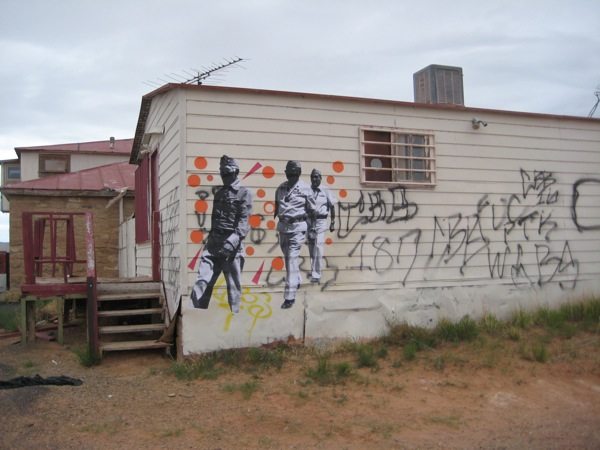
Chip Thomas Puts Public Art Around Navajo Lands
The exhibit by artist Chip Thomas, “Culture Clash,” is over at the Center for Contemporary Arts Muñoz-Waxman Gallery in Santa Fe. But that was just a citified sampling of Chip Thomass real work on the Navajo Nation.
You missed it. The naked Indian, The man sleeping between a cluster of head-butting sheep while his privates peeled off — a Xerox-paper, wheat-pasted photograph appearing on the side of the Muñoz-Waxman Gallery in Santa Fe. He was giant and pixelated and now hes probably gone, ripped to shreds by the apocalypse winds of Santa Fe.
Inside the gallery, a less ethereal collection of Chip Thomas photographs lined the walls. These photos were bold and big, 10 giant black-and-white images of Navajo men and women moving through life. Their subjects: Three decorated code walkers, one with his enlarged hand offering peyote. A pregnant princess (complete with a yellow crown) gazing down at her swollen, pregnant belly. An old man guzzling the last drops from a tilted canteen. An old woman, heavy with turquoise jewels, frowning out from under her umbrella.
“Look at us,” the photos say, “every joy, pain, and wrinkle.”
Some people didnt like the public display of nudity. Others didnt like the peyote buttons. These people must not have paid attention to the shows title: “Culture Clash.”
“Culture Clash,” at least at the Muñoz-Waxman gallery, is over. But that was just a citified sampling of Chip Thomass real work on the Navajo Nation, anyway. His photographs are blown up and pasted on kiosks, water tanks, and buildings along Highway 160. Thats west of Kayenta and over to Tuba City, then left toward Flagstaff or right toward Paige on 89 North. They are your reward for missing the left turn toward the Grand Canyon.
Ive never met Thomas in person. But heres what I do know about him: Hes an African American physician who has worked on the Navajo Nation for the last 22 years. Hes starting to deliver the babies of babies he delivered two decades ago. Thomas has also studied photography under James Nachtwey, street art in Rio, and cycled the length of Africa. Hes been inspired by the public art of French photographer JR, who traveled through Sierra Leone, Liberia, Southern Sudan, and Kenya with his 28mm lens to photograph and film truly courageous women for his “Women Are Heroes” project. Like JR, Thomas is on a mission to make art for the masses, placing it between the mesas, arches, and sacred mountains for all to enjoy.
Since Thomas started pasting his photographs, most of which last a week or two before theyre destroyed by the wind and the rain, questions have bubbled up within the Navajo community: What does in mean to place art in common spaces in a culture without a tradition of public art? How does one project in a way thats culturally sensitive, yet still expresses personal creative interests? Is it okay to paste without permission?
If youre in Albuquerque, no way. The cops will bust you faster than you can shake a spray paint can. But maybe theres more room for expression on the res. If not, Thomass Brazil photos will be hanging in the ambient light of Gallups Crashing Thunder Studio next April.
